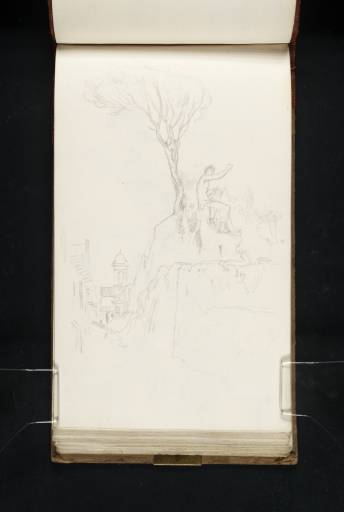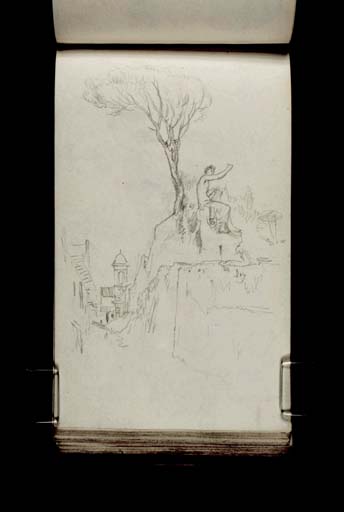Joseph Mallord William Turner The Vicolo Sterrata, Rome, with the Statue of Apollo in the Gardens of the Palazzo Barberini 1819
Image 1 of 2
Joseph Mallord William Turner,
The Vicolo Sterrata, Rome, with the Statue of Apollo in the Gardens of the Palazzo Barberini
1819
Joseph Mallord William Turner 1775–1851
Folio 70 Verso:
The Vicolo Sterrata, Rome, with the Statue of Apollo in the Gardens of the Palazzo Barberini 1819
D15430
Turner Bequest CLXXXII 69 a
Turner Bequest CLXXXII 69 a
Pencil on white wove paper, 189 x 113 mm
Accepted by the nation as part of the Turner Bequest 1856
References
1909
A.J. Finberg, A Complete Inventory of the Drawings of the Turner Bequest, London 1909, vol.I, p.539, as ‘Statue of Apollo (?) in a garden’.
1984
Cecilia Powell, ‘Turner on Classic Ground: His Visits to Central and Southern Italy and Related Paintings and Drawings’, unpublished Ph.D thesis, Courtauld Institute of Art, University of London 1984, pp.113, 142, 356, 423, reproduced pl.45, as ‘Statue of Apollo in the gardens of Palazzo Barberini and the church of S. Caio’.
1987
Cecilia Powell, Turner in the South: Rome, Naples, Florence, New Haven and London 1987, pp.[40], 51 note 9, 58, 175 note 16, reproduced p.[41] pl.42, as ‘Statue of Apollo in the gardens of Palazzo Barberini and the church of S. Caio’.
Cecilia Powell has identified this drawing as a view of the Vicolo Sterrata, a rustic looking street which once ran behind the gardens of the Palazzo Barberini and is today the via Barberini. In his book Walks in Rome, Augustus J.C. Hare recalled this celebrated picturesque corner of the city:
Till late years, there was a pretty old-fashioned garden belonging to this [Barberini] palace, at one corner of which – overhanging an old statue – stood the celebrated Barberini Pine, often drawn by artists from the Via Sterrata at the back of the garden, where statue and pine combined well with the Church of S. Caio; but, alas! this magnificent tree was cut down in 1872, and the church has since been destroyed.1
As Hare notes, the motif of the large stone pine and the adjacent statue of the Apollo Citerado (i.e. playing the cithara) offered an attractive proposition for artists and the spot was painted by a number of nineteenth-century painters including Jean-Baptiste-Camille Corot (1796–1875), Ettore Roesler Franz (1845–1907),2 and the Danish artist Constantin Hansen (1804–1880).3 The statue can still be found within the grounds of the palace but now stands in a niche at the back of the gardens. The bell-tower in the background belongs to San Caio, a church which was demolished in 1880 to make way for the building of the Ministry of War.4
The location was also the subject of a poem by the American writer and social activist, Julia Ward Howe (1819–1910). A verse entitled ‘Via Felice’ contains the stanzas:
’Twas in the Via Felice
My friend his dwelling made,
The Roman Via Felice
Half sunshine, half in shade.
My friend his dwelling made,
The Roman Via Felice
Half sunshine, half in shade.
A marble God stands near it
That once deserved a shrine,
And, veteran of the old world,
The Barberini pine.5
That once deserved a shrine,
And, veteran of the old world,
The Barberini pine.5
A further sketch of the statue can be found in the Vatican Fragments sketchbook (see Tate D15245; Turner Bequest CLXXX 49).
Nicola Moorby
May 2008
En gade i Rom. Vicolo Sterrato [A Street in Rome. Vicolo Sterrato] circa 1837, oil on white wove paper, Statens Museum for Kunst, Copenhagen. Cecilia Powell also notes views by T.H. Cromeck in 1831 and W. Cowan in 1828, Powell 1987, p.202 note 13.
How to cite
Nicola Moorby, ‘The Vicolo Sterrata, Rome, with the Statue of Apollo in the Gardens of the Palazzo Barberini 1819 by Joseph Mallord William Turner’, catalogue entry, May 2008, in David Blayney Brown (ed.), J.M.W. Turner: Sketchbooks, Drawings and Watercolours, Tate Research Publication, December 2012, https://www


